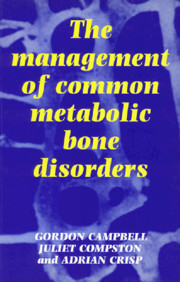1 - The pathogenesis and investigation of metabolic bone disease
Published online by Cambridge University Press: 06 July 2010
Summary
The physiology and biochemistry of bone
Bone composition and structure
The adult skeleton contains 99% of the total body calcium. It serves three main functions: first, it has an important mechanical function and serves as a site for the attachment of muscles, secondly, it protects vital organs and accommodates the bone marrow, and thirdly it serves an important metabolic function, providing a huge reservoir of calcium and phosphate ions. Bone is a connective tissue composed of an extracellular collagenous matrix (Type 1 collagen) and a ground substance containing glycosaminoglycans. Within, and on, this matrix are crystals of hydroxyapatite which provide the mineralised phase of bone. In adult bone, the collagen fibres show a preferential orientation, resulting in a lamellar appearance (Fig. 1.1); these lamellae generally run parallel to one another in trabecular bone and are arranged in concentric rings in cortical bone. Woven bone is characterised by randomly orientated collagen fibres and occurs in growing bone and in disease states characterised by increased bone turnover.
Non-collagenous proteins comprise 10–15% of total bone protein and include cell attachment proteins such as fibronectin, thrombospondin, osteopontin and bone sialoprotein, glycosaminoglycans, gamma-car-boxylated (gla) proteins, notably osteocalcin and growth factors, for example, bone morphogenetic proteins and insulin-like growth factors. The functions of these proteins are poorly understood but include osteoclast attachment to mineralised bone matrix, collagen fibrillogenesis, mineralisation of bone matrix and regulation of bone remodelling.
- Type
- Chapter
- Information
- The Management of Common Metabolic Bone Disorders , pp. 1 - 28Publisher: Cambridge University PressPrint publication year: 1993



